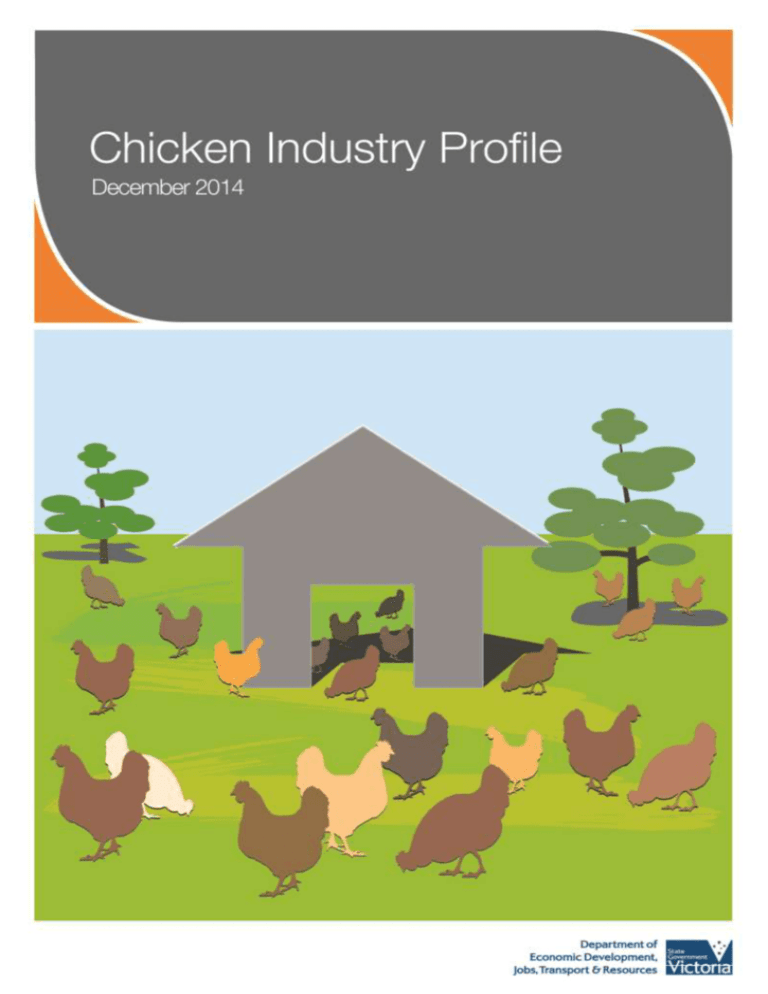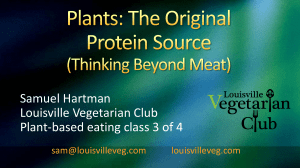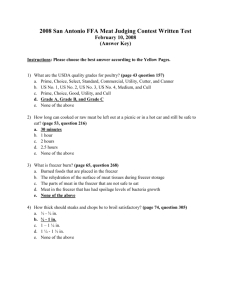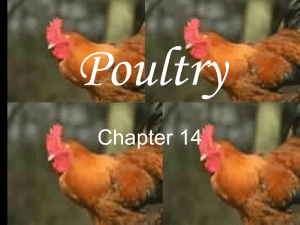Location of Victoria`s chicken meat industry
advertisement

Victoria's Chicken Meat Industry
December 2014 Update
Key points
The Chicken Meat Industry Profile provides an overview of the location, structure, production and performance of
Victoria’s chicken meat industry.
In 2013-14, Victoria produced 243,000 tonnes of chicken meat, accounting for around 22 per cent of Australia’s
1,084,000 tonnes of chicken meat production1.
Consumption of poultry in Australia, of which chicken meat is around 96 per cent, has increased from around 4.4
kg per person per year in 1960 to around 44.0 kg in 2012-132. This has been driven by a number of factors
including chicken meat becoming more price competitive and improving community perceptions of chicken meat
as a consistent, healthy, versatile and convenient product.
Consumer demand is expected to remain high as chicken meat prices will continue to be substantially lower than
prices of most alternative meats, despite the effect of forecast higher feed grain prices.
The chicken meat industry is vertically integrated with companies often owning facilities across the supply chain.
However, around 200 independent farmers are contracted to grow meat chickens (generally referred to as broilers)
on behalf of processors.
Victoria exports on average 3 per cent of its chicken meat production as a result strong domestic consumption
trends.
Location of Victoria’s chicken meat industry
Broiler farms, where day-old chicks are raised to slaughter weight at between 35 and 55 days, are generally located
within 100 km of their contracted processing facilities. Processing facilities are located within 80 km proximity of
metropolitan centres to minimise transport costs, improve access to infrastructure and labour and be near their
customer bases. Production is located primarily in the Port Phillip and Westernport region (64 per cent by gross value
of production), Barwon (18 per cent), Gippsland (9 per cent) and Loddon (7 per cent) regions 3.
Breeding farms are generally separate from broiler farms to reduce biosecurity risks. They are mainly located in the
Port Phillip, Barwon, Loddon and Goulburn regions.
Figure 1 – Victoria’s chicken meat production regions4
1
Structure of Victoria’s chicken meat industry
The Victorian chicken meat industry is highly vertically integrated and processing companies generally have
investments across the supply chain. This may include breeding farms, feed mills, hatcheries, grow-out/broiler farms
and processing plants.
There are also around five Victorian breeding facilities and a number of broiler farms growing chickens in their own
right5. Victoria has an estimated 220 businesses involved in chicken meat production6. Majority of these broiler farms
are growing meat chickens under contract for the one of the three large processors. Under this arrangement, the
processor retains ownership of the birds throughout the supply chain.
At any one time in Victoria, there are around 21 million broilers being raised for meat production 7 and around 800,000
breeding stock8.
Well over 95 per cent of the chicken meat grown and eaten in Australia is produced by seven privately owned
Australian chicken meat processing companies. The two largest, Baiada Poultry and Inghams Enterprises, supply
more than 70 per cent of Australia’s chicken meat, with the next five companies each supplying between three and
nine per cent of the market. A large number of smaller processors make up the balance.
There are four main processing companies in Victoria – Inghams Enterprises, Baiada Poultry Pty Ltd, Hazeldene’s
Chickens Pty Ltd and Turi Foods Pty Ltd. There are also several smaller processors in Victoria.
Figure 2 – Chicken meat industry supply chain
Quarantine
Breeding Farms
Eggs are imported from US
and UK suppliers of meat
chicken genetic material.
The eggs are hatched and
raised to 9 weeks in
quarantine facilities. (The
hatched birds are great
grand parent birds.)
The great grand parent
birds are bred out for
several generations.
The great grandparent
offspring are then
raised for meat
production.
Grow out (broiler)
farms
The one day old
chickens hatched from
the parent generation
are delivered by the
processing company to
its own farms or
contracted farms. They
are grown out for
30-55 days.
Processing
The processing company
selectively collects chickens
of varying sizes from the
broiler farms depending on
its needs. The chickens are
then processed into a range
of fresh, chilled, frozen and
value added products.
Victoria’s chicken meat production
Australian chicken meat production increased by 4 per cent from the previous year to 1.08 million tonnes in 2013-14,
from approximately 580 million meat chickens9. The forecast for 2014-15 is for a further increase of 4 per cent to 1.12
million tonnes.
In Victoria, around 137 million chickens were processed in 2013-14, producing around 243,000 tonnes of chicken
meat. The amount of chicken meat produced in Victoria has been increasing (Figure 3), especially at a higher rate
from 1996-97. After 2008-09 however, the total Victoria production has plateaued. Victoria is the second largest
producer of chicken meat in Australia accounting for 22 per cent of national production. In 2012-13, the gross value of
production for Victoria’s poultry meat industry was $563 million10.
2
Over the past decade, the poultry industry has achieved significant productivity growth by improving genetic stocks,
husbandry procedures and processing technology, which has led to increased slaughter weights and lower growth in
production costs. The average weight of meat production per bird stays unchanged after increasing by 1 per cent to a
record 1.9 kilograms in 2010-11, 16 per cent higher than a decade ago11. The average carcass weight represents the
most commonly sought after size for retail and wholesale consumers. The increased size of the meat chickens in
Australia mainly reflects improved genetics.
No hormones are used in chicken meat production in Australia.
Improvements in the ability of certain breeds of chickens to convert feed have decreased the time that it takes for
chickens to reach full size and allow farmers to raise more batches of chickens in a year. According to the Australian
Chicken Meat Federation Inc., feed conversion efficiency has improved from 2.33 kg of feed per kg live weight in 1975
to 1.70 in 2011. Improvements to animal nutrition and health management practices have also increased efficiencies
in production12.
Figure 3 – Chicken slaughterings and meat production in Victoria13
300
Left - number slaughtered
Right - meat produced
140
250
120
200
100
80
150
60
100
40
50
20
0
196566
Meat Producerd, Victoria ('000 tonnes)
Numbers slaughtered, Victoria (million
birds)
160
0
197071
197576
198081
198586
199091
199596
200001
200506
201011
Production systems
Chicken meat production can occur under a number of production systems, including conventional sheds, free-range
and organic, giving consumers greater choice. Each system has different requirements in relation to components such
as stocking densities and the use of purpose developed feed and medication. The costs of production, and
subsequently the retail price of the products offered, also vary between systems.
3
Victoria’s exports and domestic consumption of chicken meat
Around 97 per cent of chicken meat production in Australia is consumed by the domestic market. Per capita
consumption of chicken meat has been increasing steadily and now exceeds beef and veal (Figure 4). Consumption
of poultry meat – of which chicken is around 96 per cent – increased from 4.4 kg per person in 1960 to a peak of 44.0
kg in 2011-1214. This makes Australia the second largest consumers of chicken meat per capita after Brazil 15.
Chicken consumption has risen almost 1 per cent in the last year, and is expected to continue to maintain its place as
the most popular meat in the next few years. Australian Bureau of Agricultural and Resource Economics and Sciences
(ABARES) estimates that chicken meat consumption in Australia will continue to rise, reaching 47 kg per person per
year by 2017-18. In comparison, per person consumption of beef and veal, pig meat and sheep meat is expected to
average 33 kg, 26 kg and 10 kg, respectively.
The most important factor in this growth has been the price competitiveness of chicken meat relative to other meats
over the long term, as shown in Figure 5. This is due to improved production efficiencies, the automation of the
processing sector and rationalisation and integration in the supply chain.
The increase in demand from consumers has also been supported by the processing and retail industry taking
advantage of value adding opportunities and an increased recognition of chicken as a safe, consistent, versatile and
easy to use product. In the 1960s, whole birds represented the main product sold. Since then there has been strong
growth in demand for chicken cuts and fillets, such as raw chicken breast fillets or chicken drumsticks, together with
increased demand for further processed chicken products. These factors have driven stronger home consumption and
supported the establishment and continued growth of chicken based fast food and food service outlets.
Supply to the domestic market has historically come from processors within the state of production. This is particularly
the case for fast food and food service outlets, which generally require daily deliveries of fresh chicken. While
Australian processors are likely to continue to dominate supplies of chicken meat domestically, there is also some
limited scope for overseas suppliers to compete with local cooked chicken meat products.
Figure 4 – Apparent per capita meat consumption in Australia16
Per capita meat consumption (kg)
60
Beef and Veal
Lamb and Mutton
Pig Meat
Poultry Meat
50
40
30
20
10
0
1980-81
1985-86
1990-91
1995-96
4
2000-01
2005-06
2010-11
Figure 5 – Retail meat prices (per kg) in Australia17
2,000
Beef
Lamb
Pork
Chicken
Price (cents/kg)
1,500
1,000
500
0
1991
1996
2001
2006
2011
Australia exported around 38,000 tonnes of chicken meat valued at $53 million in 2013-14 with Papua New Guinea,
the Philippines, Hong Kong and South Africa accounting for over three-quarters of total shipments18. Around 94 per
cent of Australia’s chicken meat exports consisted of cuts and edible offal and the remainder was mainly whole
chickens. Victoria accounted for around $21 million of these exports in 2013-14.
Total factor productivity
There is no information available on total factor productivity for the poultry or chicken industries. However, the ability
of the chicken meat industry to maintain a relatively consistent and competitive price by improving production and
processing efficiencies and rationalisation suggests the industry has been experiencing reasonable productivity
growth. Enhanced productivity in the chicken meat industry can be attributed to factors such as specialist breeding for
better feed conversion, more sophisticated shed types, automation in processing and improved waste management 19.
Prices
Farm gate prices for chickens are determined by the terms and conditions of the contract between the grower and the
processing company and as such are not publicly available. ABARES’ indexed prices suggest that the real prices
received by poultry growers in Australia have peaked in 2008-09, then declined up to 2011-12 and started increasing
again.
5
Figure 6 – Indexed prices received by poultry meat producers in Australia20
Index of prices received by farmers
140
Change in poultry meat prices
Baseline (1997-98 price)
120
100
80
60
40
20
0
2000-01
2004-05
2008-09
2012-13
Farm financial performance
There is no quantitative information available on the financial performance of broiler farms. However, this farming
sector enjoys relative security compared with other livestock industries since contract growers do not pay for feed,
stock or veterinary costs. Financial insecurity can be caused by a decrease in the number of chickens placed on a
farm by the processors. Since January 2014, 100 per cent of Coles home brand fresh chicken have been Royal
Society for the Prevention of Cruelty to Animals (RSPCA) Approved. Coles has been selling RSPCA approved
chicken meat since 2011. Its research indicated that customers would buy more fresh chicken meat if improved
welfare options were available.
Meeting the RSPCA Standard will increase chicken farmers’ costs due to the need for more space for birds (lower
broiler shed densities), installing perches, more lighting, deeper litter and higher audit, labour and transport costs. The
Standard may also have implications for labour costs and feed quality control, due to the need to meet stricter
standards for bird welfare.
The main input costs for the chicken meat industry are asset management, labour costs and feed. The broiler farmers
are generally responsible for asset management and labour, while feed and day old broilers are usually provided
under contract by the processing company.
Employment
In 2011, around 1,522 people were employed on poultry farms in Victoria and around 2,660 were employed in the
manufacturing of poultry products in Victoria. The 1,522 people employed in poultry production included 370
employed in the poultry meat industry, 734 employed in the poultry egg industry and 418 for which the data available
does not distinguish between egg or meat production21.
Government policy/regulation influences
Broiler farmers are required to comply with a range of policies relating to food safety, animal welfare, biosecurity and
the environment – for example, the Code of Accepted Farming Practice for the Welfare of Poultry and the Prevention
of Cruelty to Animals Act 1986. New broiler farm developments and capacity expansions must also comply with the
Victorian Code for Broiler Farms 2009.
The industry is developing a strategic vision for the Victorian chicken meat industry which is being jointly funded by
industry and government.
Through a technical workshop held in 2014, the broiler industry heard and discussed the most recent research about
odour emissions from free range farms as well as best practice for the spreading of non-composted poultry litter on
farm. A technical reference group was also created to develop clear and workable odour modelling guidelines for
undertaking an Odour Environment Risk Assessment required for specified classes of broiler farms.
6
1
Australian Bureau of Statistics (ABS), Livestock Products, Australia, June 2014, 7215.0
2
Australian Bureau of Agricultural and Resource Economics and Sciences (ABARES), Australian Commodity Statistics, September
2014
3
ABS, Value of Agricultural Commodities Produced, Australia, 2012-13, 7503.0
4
ABS. Based on AGS2011 Mesh Block Boundaries. Number of live poultry (meat chickens) sourced from the 2000-11 Agricultural
Census. Land use based on ASGS2011 Mesh Block Use Categories. This map was produced using coordinate system: Lat/Long
GDA94 © Commonwealth of Australia, 2014
5
Australian Chicken Meat Federation Inc. (ACMF), unpublished data, December 2014
6
ABS, unpublished data, 2014
7
ABS, Agricultural Commodities, Australia, 2012-13, 7121.0
8
9
ACMF, unpublished data, December 2014
ABS, Livestock Products, June 2014, 7215.0
10
ABS, Value of Agricultural Commodities Produced, Australia , 2012-13, 7503.0
11
ABARES, Agricultural Commodity Statistics, 2013
12
Australian Chicken Meat Federation Inc. (ACMF), The Australian Chicken Meat Industry: An Industry in Profile 2011
13
ABS, Livestock Products, various years, 7215.0
14
ABARES, Australian Commodity Statistics, 2013
15
ACMF, The Australian Chicken Meat Industry: An Industry in Profile 2011
16
ABARES, Agricultural Commodity Statistics, various years
17
ABARES, Agricultural Commodity Statistics, various years
18
Department of Environment and Primary Industries (DEPI), Victorian Food and Fibre Export Performance Report 2013-14
19
ACMF, The Australian Chicken Meat Industry: An Industry in Profile 2011
20
ABARES, Agricultural Commodity Statistics, various years
21
ABS, 2010-11 census of population and housing
7








